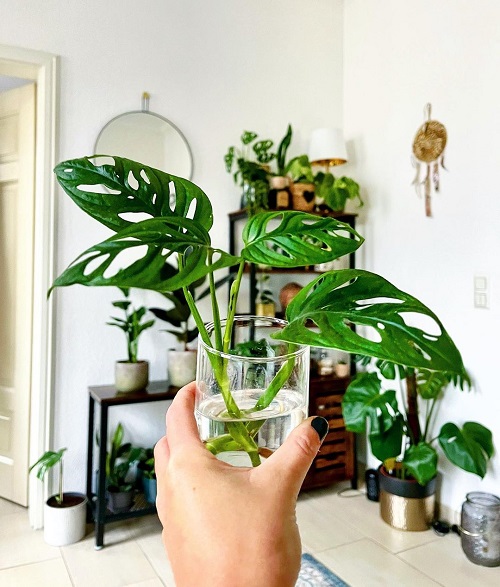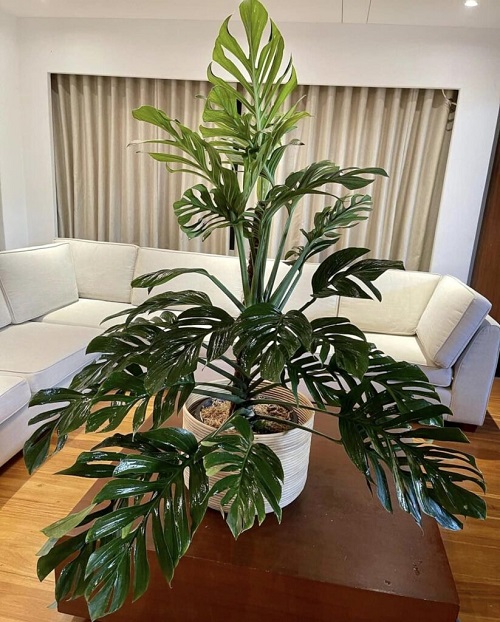Monstera pinnatipartita can be a fantastic indoor specimen with large and serrated foliage. Here are all the details to grow it.

Give a look at the essential steps for propagation, care, and maintenance to ensure healthy growth and vibrant foliage for Monstera pinnatipartita, a captivating tropical plant.
Read Monstera Albo Care and Growing Guide here
Monstera Pinnatipartita Information
Monstera pinnatipartita is an evergreen plant that climbs using epiphytic aerial roots and can grow up to 2 feet per year under optimal indoor conditions.
What distinguishes this rare species is the extended fenestration on its dark green, heart-shaped leaves compared to some more familiar Monsteras. Surprisingly, Monstera pinnatipartitas are easy to care for, despite their show-stopping appearance.
While mature plants undoubtedly possess the wow factor, the foliage of juvenile plants is solid rather than fenestrated. If you choose to buy a baby plant, you’ll need the patience to witness the payoff.
Check 26 Plants that Look like Monstera but are not here
Propagating Monstera Pinnatipartita

Propagation in Soil
To propagate a Monstera pinnatipartita using a cutting, follow these steps:
- Use sterile shears to take a 4 to 6 inches cutting from a healthy stem, making the cut just below an intact leaf node.
- Remove any foliage from the bottom third of the cutting. Dip the cut end of the stem into a rooting hormone to encourage root development.
- Insert the Monstera pinnatipartita cutting into the growing medium, making sure it is securely planted.
- Place the container in a spot with bright, indirect light. Avoid exposing the cutting to direct sunlight.
- Keep the potting mix moist, but be careful not to overwater and saturate the soil.
- After a few weeks, the cutting will form roots.
Propagation in Water
- Take a 4-6 inch cutting from a healthy stem, making the cut about half-inch below an intact leaf node.
- Fill the container with water, submerging the bottom part of the cutting.
- Replace the water with fresh water every week to prevent the growth of bacteria and ensure the cutting has access to the necessary nutrients.
- Allow the Monstera pinnatipartita cutting to remain in the water, observing it as it develops roots. This process can take up to two months, so patience is key.
Propagate Any Plant Cutting Quickly Using this Trick
Requirements for Growing Monstera Pinnatipartita
Location
Proper light is essential for healthy Monstera pinnatipartita foliage. Bright, indirect light is ideal, with at least six hours of exposure a day. Avoid direct sunlight to prevent leaf damage.
Rotate the plant for even light exposure.
Soil
For Monstera pinnatipartita, it is important to avoid using dense soil. Instead, opt for a light and well-aerated mix that incorporates nutrient-rich organic material. Blending vermiculite, orchid bark, and sustainable coco coir can be excellent choices.
Learn some Great Tips to Rejuvenate Your Old Soil here
Another option is to seek out a pre-made Monstera or aroid mix that provides a balanced combination of drainage and moisture retention, which this plant prefers.
By using a moss pole, the plant can also draw nutrients from it, enhancing its overall nutrient intake.
Water
Monstera pinnatipartita prefers consistently moist soil when grown outdoors. It’s important to avoid soggy conditions that can lead to root rot. To determine when to water, check the top few inches of soil and wait until it is fully dry.
Here are the best ways to water plants
Using a moisture meter can provide a more accurate assessment of the moisture level in the root ball.
Temperature and Humidity
Monstera pinnatipartita prefers temperatures between 65°F (18°C) and 85°F (29°C). It can tolerate slightly lower or higher temperatures for short periods, but prolonged exposure to temperatures below 60°F (15°C) or above 90°F (32°C) can be detrimental to the plant’s health.
Avoid placing it in drafty areas or near temperature extremes.
Monstera pinnatipartita thrives in high-humidity environments, mimicking its native tropical habitat. It prefers humidity levels between 60% and 70%. If the humidity drops below 40-50%, it can lead to issues such as dry leaf tips or edges.
Place the plant on a tray filled with water and pebbles. Ensure that the water level does not touch the bottom of the pot to avoid waterlogging. You can also use a humidifier to raise humidity levels in the room where Monstera pinnatipartita is located.
Find How to Grow Monstera Deliciosa Fruit here
Monstera Pinnatipartita Care
Fertilizer
Regular feeding of your Monstera pinnatipartita during the spring and summer growing seasons is essential for promoting robust leaf development.
Using a slow-release balanced liquid fertilizer with a ratio of 20-20-20 is recommended. If you can find a fertilizer specifically designed for monsteras, it will provide an optimal mix of nutrients for your plant.
During the slower winter months, reduce feeding to once a month or less.
Want to Make Organic Fertilizers from Kitchen Scraps? Click here
Pruning
To maintain the appearance of your Monstera pinnatipartita, you can trim or tuck back untidy aerial roots. Trim away any unhealthy leaves to redirect energy toward the growth of healthy foliage.
If the plant becomes too tall for your space, consider trimming it back during the spring season using sterile cutting shears.
However, it’s recommended to remove no more than 25 percent of the plant’s height to ensure its overall health and vitality.
Support
As Monstera pinnatipartita grows, it will develop aerial roots, and vining stems that may require support to help the plant climb and maintain its desired shape.
A moss pole or stake provides a natural and sturdy support for your Monstera pinnatipartita to climb. Place the pole in the pot and secure it near the base of the plant.
A trellis is another popular support option. It typically consists of a lattice or grid-like structure that can be placed in the pot behind the plant.
Pests and Plant Diseases
To maintain the health and appearance of your Monstera pinnatipartita, it is recommended to wipe the foliage with a damp cloth regularly. This practice serves multiple purposes—it removes dust, keeps the leaves glossy, and helps prevent pests from infesting your plant.
Click here to learn the Amazing Natural Pesticide Recipe that can Kill any Pest
Mealybugs and spider mites can occasionally affect Monstera pinnatipartita. If you notice signs of infestation, applying neem oil or insecticidal soap can effectively eliminate these pests before they become a significant issue. Regular cleaning and proactive pest control measures will help keep your plant thriving and pest-free.



